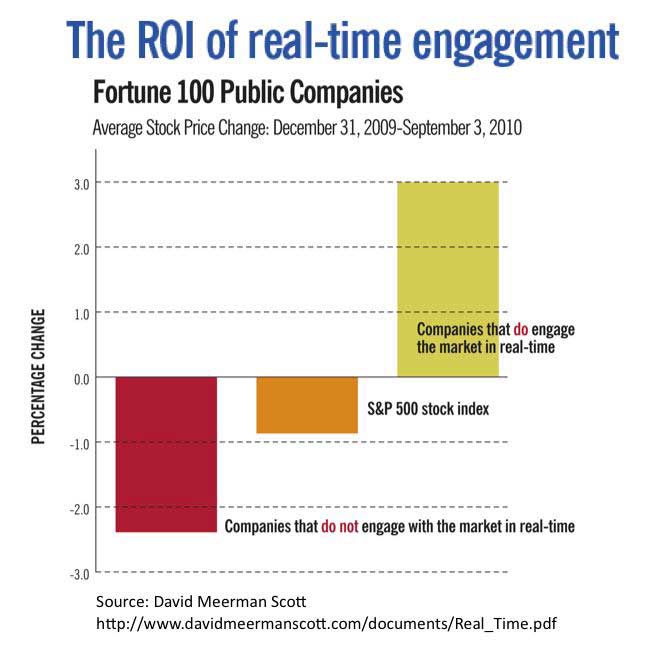In a world where speed and agility are essential to success, most organizations still operate slowly and deliberately, cementing each step months in advance, responding to new developments with careful but time-consuming processes.
The Internet has fundamentally changed the pace of business, compressing time and rewarding speed.
Real-time means news breaks over minutes, not days. It means ideas percolate and then suddenly and unpredictably go viral to a global audience. Real-time is when companies develop (or refine) products or services instantly, based on feedback from customers or events in the marketplace. And it's when businesses see an opportunity and are the first to act on it.
My first job was on a Wall Street trading desk in the 1980s. I witnessed real-time technology transforming financial trading into a game where instant information informs split-second decisions worth millions of dollars.
It has taken a quarter century. But in the case of marketing and public relations (PR), all industries are finally feeling the impact of the real-time revolution.
We can all react instantly to what's happening in the news, just like a bond trader. We can engage members of the media on their timetable, precisely when they are writing a story.
But we've got to develop a business culture that encourages speed over sloth. The MBA-style approach of working off spreadsheets that predict what to do months into the future is no help when news is breaking in your industry today.
As financial market players know, advantage comes from reacting to news first. The same thing is true for all companies.
When you start the conversation, you are recognized as someone who is plugged into the marketplace of ideas. If you talk about an idea early, you naturally get more exposure because the threads of conversation stem from what you have said. If you're late, you get lost in the cacophony.
With a new product, if you get first to market in a hot category, your initial momentum may give you an advantage for many years. If you're an early adopter on a social-media platform, you build a larger following than those who join later.
If you're first to engage the market, people notice and your offering gains valuable attention. If you react early and connect with customers as their concerns arise, they see you as thoughtful and caring.
The Fortune 100 and Speed (or Lack of It)
Throughout the past several years, as I've been working on my new book Real-Time Marketing & PR, I've been thinking about the best way to measure how the largest companies in America engage (or don't) in real time.
After mulling that over, it occurred to me that the top 100 US companies were as good a focus group as any. So I used the Fortune 500, the annual list from Fortune magazine that ranks America's top 500 public corporations by gross revenue.
I sent an inquiry via email to the media-relations department of each of the top 100 companies on the list. I asked each company to tell me how it had adapted to the new realities of the real-time Web. Here's what I asked:
Hello,
I would be grateful if you would please forward this inquiry on to the most appropriate person for response.
I am researching a story that will appear first on my blog. I am likely to also publish what I learn in an article under my byline in the Huffington Post and in a book I am currently writing due out in November 2010.
I am reaching out to other companies as well.
QUESTION: In the last year or two, has the structure of your corporate communications team and/or communications processes changed to embrace the real-time digital era? If so, how?
A sentence to a paragraph is fine as a response.
Many thanks,
David
I included my email signature with a link to my site, blog, and Twitter ID, in case recipients wanted to find out more about me right away. I heard back from just 28 of the Fortune 100 companies.
In itself, that topline result is not encouraging evidence that the lights are on in corporate America. Even more discouraging was the tone-deaf response from many who did reply. (You can read about that in my e-book: Real-Time: How Marketing and PR at Speed Drives Measurable Success [pdf])
On the other hand, it was very encouraging to find that a few companies are already very much on the ball, which gives me hope that the others will be able to catch up once they focus on the right questions.
In my e-book, you will discover the identities of the 28 companies that engage in real time and those that do not. (Feel free to jump to the appendix for how each company fared.)
Real-Time Companies Are More Successful
I'm amazed that a comparison of 2010 stock prices reveals that, on average, the publicly traded Fortune 100 companies that engage in real-time communications beat the S&P 500 stock index while the others, on average, underperformed the index.
During the period I measured—closing price on December 31, 2009, through closing price on September 3, 2010 (when my book Real-Time Marketing & PR went to print)—the stock prices of 67% of companies that operate in real time were up, while only 42% of those that do not were up.

The research confirms what I've suspected all along: Even the biggest companies can respond in real time if they put their minds to it.
Unfortunately, the research also confirms my fear. Three-quarters of the Fortune 100 either couldn't be contacted or failed to reply. They are asleep at the wheel—and that's not good enough in today's always-on world.
The companies that have developed a real-time mindset are leaders in more ways than one.
My analysis provides us with evidence that there is a positive ROI (return on investment) for investing in real-time marketing and PR. I find it fascinating that those companies that engage in real time, on average outperformed the market as a whole and dramatically beat those Fortune 100 companies that do not engage.
That is the ROI of real-time engagement.




